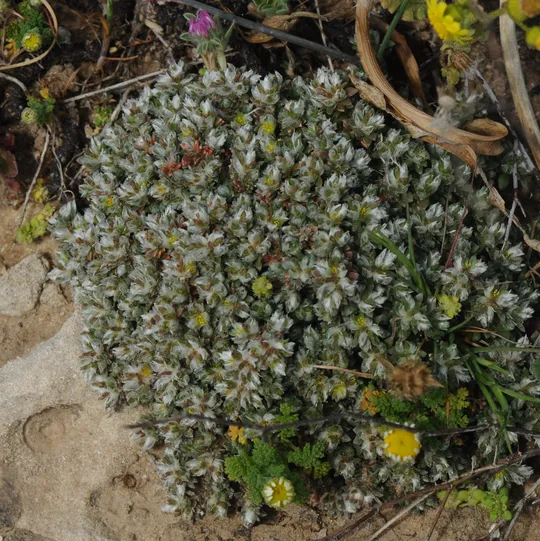Compact Velezia, Dense Velezia
Velezia fasciculata



To this day Velezia fasciculata was found at only a single site in the Acre Valley north of the Akhziv Field Studies Center (Liman Beach) on sandy soil on a stabilized sand expanse together with Artemisia monosperma and Echium angustifolium. The species was first found in 1949 and subsequently "disappeared" until 1974. Since then there have been annual observations of the population. In 1995, 8000 plants were counted at the site in an area of 0.05 ha. No other populations were found in the area or along the beach in the Haifa Bay and the Carmel Beach areas.
In Israel – stabilized sands and calcareous sandstone near the seashore. The plant was originally described from a location near Nazareth and therefore its habitat was recorded in the Flora Palaestina (1966) as shrubland.
The genus Velezia includes six species common in the eastern Mediterranean and western Irano-Turanian regions. The genus distribution center is in the Anatolian Plateau. All the species in the genus grow in Turkey. Velezia is close to the genus Petrorhagia, and there are species for which it is difficult to decide to which genus they belong.
Velezia fasciculata is similar and very close to V. rigida, but unlike V. fasciculata, V. rigida is common in mountainous regions in Israel. The inflorescence of V. rigida is not an umbel and its flowers are scattered individually along the stem. V. fasciculata is covered in glandular hairs that are missing in V. rigida.
There are arguments that the two species of Velezia should be combined, giving V. fasciculata the status of a variety within V. rigida (Velezia rigida var.fasciculata (Boiss.) Post, 1883). In the Flora of Turkey, the investigator Kod noted that the herbarium specimen of V. fasciculata collected by Borenmoir from the Nazareth area is most probably not V. fasciculata. This can explain the fact that the Flora Palaestina and other guides determine that the habitat of V. fasciculata is shrublands, whereas we emphasize that the species in Israel grows in coastal sands.
• Velezia fasciculata was found to date at a single site north of the Akhziv Field Studies Center on sandy soil in a stabilized sand field together with Artemisia monosperma and Echium angustifolium.
• The population extends along the sides of the scenic coastal road between Akhziv and Rosh HaNikra. There are no signs posts or fences, thus exposing the population to unintentional damage by vehicles; off-road vehicles (ORV) can easily destroy the seed bank.
• The site is located on the border of the Rosh HaNikra Coastal Reserve, behind the fences of the regional manufacturing plants.
• Despite the fact that V. fasciculata is an annual species, its population is stable. The site has thousands of plants, which have been regularly observed since 1974.
• The global distribution of V. fasciculata is limited to our region, and has been found in only a few sites in Syria and Turkey in coastal areas subject to intensive development pressure.
The Velezia fasciculata population on the Liman Beach should be fenced and monitored twice a year. The Acacia saligna trees at the site should be destroyed, and shade bushes should be prevented from penetrating into the clearing. Demographic monitoring should check to see if the population has spread to other nearby sites and perhaps even attempt to populate two nearby sites with V. fasciculata.
The distribution of Velezia fasciculata is limited to northern Israel, (absent in Lebanon) western Syria and southern Turkey.
Velezia fasciculata is a small, inconspicuous annual plant that grows on stabilized sand on calcareous sandstone along the coast. It has been found to date at a single site. V. fasciculata is a northern peripheral species with an extremely limited global distribution. It grows only in southern Turkey and Syria on the Mediterranean coast, an area subject to intense development pressure.
Current Occupancy Map
| 1000 squre meter pixel | 5000 squre meter pixel | 10000 squre meter pixel | |
|---|---|---|---|
| number of observations | 0 | 0 | 0 |
| in total pixels | 0 | 0 | 0 |
| Family | Caryophyllaceae |
| Classification | On the endangered species list |
| Ecosystem | Coastal area |
| Chorotype | Eastern Mediterranean |
| Conservation Site | Liman Beach north of the Akhziv Beach |
| Rarity |
1
4
6
|
|---|---|
| Vulnerability |
0
4
4
|
| Attractiveness |
0
0
4
|
| Endemism |
0
2
4
|
| Red number |
1
5.8
10
|
| Peripherality | N |
| IUCN category | DD EW EX LC CR EN VU NT |
| Threat Definition according to the red book | Critically endangered |
 Based on:
Based on:






